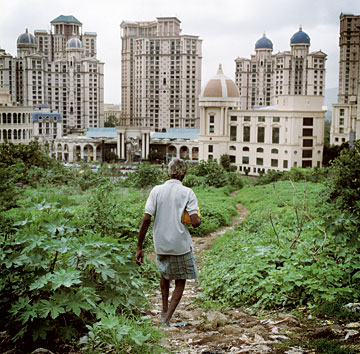
Divided land: In Mumbai, India's boom has widened the gap between rich and poor
Hoang Van Ti was one of the winners when Vietnam ended its long period of isolation and joined the global economy. Foreign investors flocked to the communist country, new factories making computers, clothing and other goods for export rose from the country's rice paddies, and suddenly jobs were no longer in short supply. In 2007, Ti landed work near Hanoi at a South Korean – owned kitchenware manufacturer, where he attached handles to pots on an assembly line. The pay, at $105 a month, was much more than the 22-year-old could ever earn back in his farming village of Hau Loc in central Vietnam. But two months ago, the world's severe economic slowdown hit home. Orders at Ti's factory dried up; his manager furloughed him indefinitely. Ti can no longer help his family in Hau Loc by sending them extra cash. As he chain-smokes at a makeshift tea stall near Hanoi, he longs to get back on the road to prosperity. "I'm trying to stay here to find another [factory] job," he says, "because life is even more difficult back home."
As the economic slump deepens, stories like Ti's are playing out with dismal regularity all over the world. From Mexico to Malaysia and Bahrain to Botswana, poor nations that bought into the promises of globalization benefited mightily as increased investment and trade generated new jobs, lifting hundreds of millions of people out of poverty. But the crash of consumer spending in the West is idling the manufacturing engines that drove much of the developing world's economic growth. In Asia and Africa, leaders fret that large swaths of the population could be plunged into destitution. In China — that modern-day paragon of economic bootstrapping that has provided a blueprint for so many other countries — exports are plunging, tens of thousands of factories are closing and tens of millions of newly unemployed workers are migrating from coastal cities back to their impoverished home villages. Globalization, the greatest poverty-alleviation machine the world has ever seen, looks to be losing its ability to transform lives for the better. The export-led growth model "in a medium and long-term sense is coming under stress," says Ajay Chhibber, director of the Asia bureau at the United Nations Development Program (UNDP) in New York City. As a result, "it will be much harder to maintain progress on poverty reduction." (See pictures of China on the wild side.)
The Asian Way
Nowhere is this stress more evident than in East and Southeast Asia, where countries including South Korea, Taiwan and Thailand proved for half a century that economic miracles were possible. While most of the developing world in the 1950s and 1960s tried socialist experiments or nationalistic, state-dominated strategies to end poverty, Asia was busy employing some old-fashioned capitalist tools by encouraging entrepreneurs, exports and foreign investment. Industrial enterprises, both foreign and local, multiplied, tapping low-wage labor to become internationally competitive exporters that shipped toys, textiles and TV sets to the U.S. and Europe. Farmers found new jobs on assembly lines, and their incomes soared. In 1981, nearly 80% of East Asians lived on less than $1.25 a day, according to a recent World Bank study; by 2005, only 18% did. Compare that record to sub-Saharan Africa, where countries didn't connect to the world economy as successfully as Asia. There, the poverty rate remained stuck at around 50% from 1981 to 2005.
Globalization worked. China adopted the strategy after Deng Xiaoping's reforms began in 1978. The results were spectacular, and by the 1990s, most developing countries were to varying degrees turning to export-led manufacturing to boost their economies. India joined the party after Prime Minister Manmohan Singh, then Finance Minister, introduced reforms beginning in 1991 that dismantled the stifling network of state controls and licenses known as the "license Raj." The Gulf emirate of Dubai has enjoyed a boom by reinventing itself as a major finance and trading hub for international companies. Countries as diverse as Togo, Kazakhstan and Jordan have advertised on CNN in search of foreign investors.
Today, amid the financial meltdown, it is those very nations that have gained most from the global economy that are suffering the most. Jing Ulrich, chairman of China equities at JP Morgan in Hong Kong, estimates that 60,000 enterprises shut in China's Guangdong province alone in 2008, as export orders and credit dried up. The Chinese government says that 10 million migrant workers have lost their jobs. In January the Federation of Indian Export Organizations warned that 10 million Indian workers might lose theirs in coming months, amid what A. Sakthivel, the group's president, called "the worst year in history" for exporters. Some 300 million people in Asia alone are so close to the poverty line that the economic downturn could push them back below it. Even those parts of the emerging world not as exposed to the shrinkage of global trade are at risk. Tito Mboweni, governor of the South Africa Reserve Bank, warned in October that the economic crisis could "undermine the policy gains we have made over the last decade." Says the UNDP's Chhibber: "At a minimum, the progress on poverty could be stalled — but it could even be reversed."